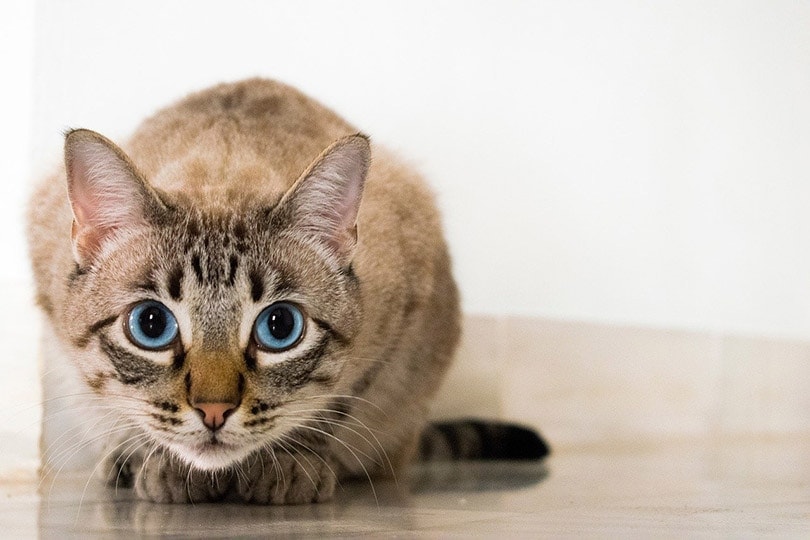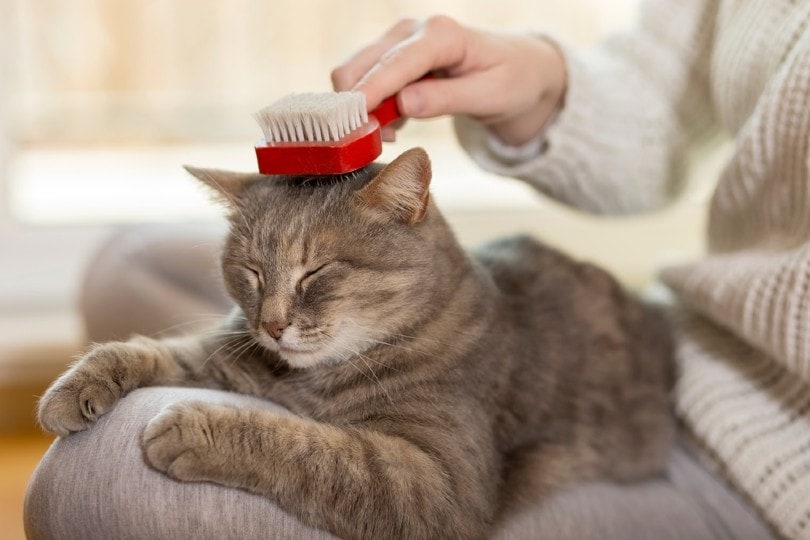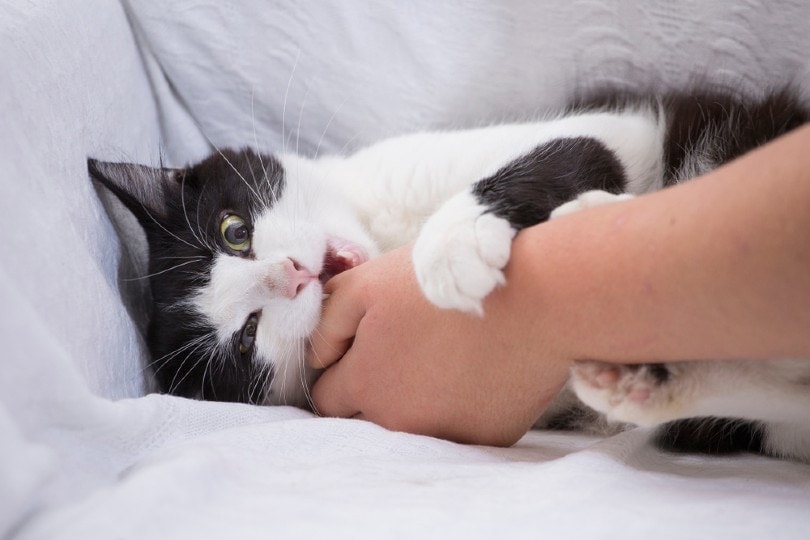How to Trim Cat Nails in 5 Simple Steps: Vet-Approved Tips & Alternatives

Updated on
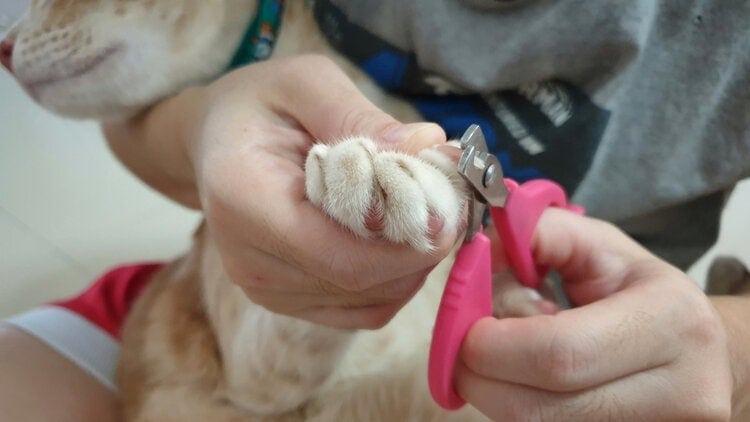
Click to Skip Ahead
Keeping a cat’s claws properly trimmed is a vital part of pet maintenance that not only safeguards you and your loved ones but also preserves the integrity of your household furniture.
Regular nail trims are also a healthier, more humane alternative to declawing, a procedure that can lead to adverse health and behavioral outcomes. However, not all cats require their claws to be trimmed, and it will depend on their age, health, and lifestyle. So, let’s cut to the chase and look at five simple tips for trimming your feline friend’s nails.
The 5 Steps to Trim Your Cat’s Nails
1. Selecting the Perfect Tools
Setting up with the right tools is paramount for a smooth cat nail-trimming experience. Here’s a simple guide:
- Identify the Appropriate Tool: Cat nails are very different from ours, which is why it is important to use special cat nail clippers that allow for safe and efficient nail trimming. There are several different types, but the most common ones resemble scissors yet are not as sharp as scissors are.
- Ensure the Nail Clippers Are Working Properly: Before trying them on your cat’s nails, inspect the clippers and make sure the jaws meet properly and function well without getting stuck, and make sure you familiarize yourself with how they work.
- Learn the Correct Process for Nail Trimming: Speak to your vet or a professional cat groomer about the correct and safe way to trim your cat’s nails, and practice in their presence before embarking on this journey yourself if you are not comfortable with it.
- Get a Friend or Family Member to Help: Trimming cat nails is best done with two people, as cats can be wriggly, and it takes experience to be able to do it yourself, so grab someone who can either hold your cat gently or trim the nails while you hold them.
Remember, the right tool can make the nail-trimming process less daunting and more efficient for both you and your cat.
Trimming your cat's nails isn't the easiest task in the world, but a well-designed set of clippers can make all the difference. Our Hepper Cat Nail Clipper Set features two sizes of clippers with easy-to-clean stainless steel blades and a built-in safety guard to prevent accidental cuts. These clippers are comfortable to hold, nicely designed to work at tricky angles, and even include a bonus hidden nail file and a convenient pouch!
2. Fostering a Gentle Hold
Establishing a firm yet gentle hold on your cat is an art that requires patience and practice. Here are some tips:
- Maintain a Comfortable Hold: Depending on your cat’s temperament, rest your cat in the crook of one arm while holding a paw with your free hand, or place the cat on a table and lift one paw at a time.
- Involve a Partner if Possible: A partner can help distract your cat with treats by holding or petting them while you handle the trimming.
Before long, your cat will grow accustomed to the trimming routine, and this will be an opportunity for some quality bonding time.
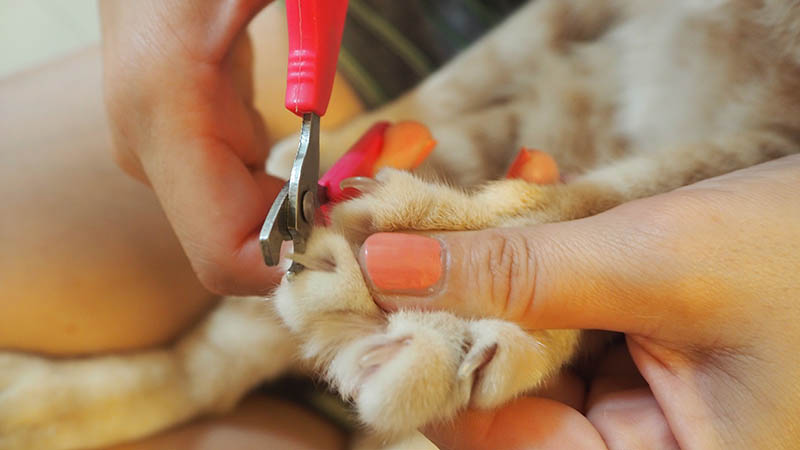
3. Identifying the Right Angle
Positioning the claw correctly is crucial to ensure a safe and painless trim. Follow these steps:
- Extend the Claw: Gently press down on the top and bottom of the paw at the joint just behind the claw. This will cause the claw to extend.
- Trim Carefully: With the claw extended, snip off the sharp tip, taking care not to cut into the quick, sensitive pink area that can cause bleeding.
- Manage Any Bleeding: If you accidentally cut into the quick, put pressure on it using gauze for a few minutes, and if that doesn’t help, apply styptic powder or a little bit of baking powder or flour. You can also rub the nail across a dry bar of soap to stop the bleeding.
Don’t get discouraged if you don’t get it right the first time. Reevaluate the procedure to see what went wrong and how to prevent it in the future, and then practice these steps. Or you can do it under your vet’s supervision on the first few occasions until you get more proficient. In time, you’ll be well-prepared to trim your cat’s nails safely and confidently.
4. Checking All Claws
It is essential to check all your cat’s claws to ensure their comfort and prevent potential damage. Follow these steps:
- Inspect All Claws: Remember that while the front claws are more commonly trimmed, the rear claws might also need attention.
- Prioritize Based on Comfort: Start with the front claws and only proceed to the rear ones when your cat is calm and cooperative. You may need to do one leg at a time or even one paw per day. It’s important to be patient and calm and keep your cat comfortable during the process. You don’t want them getting stressed every time you do it.
This balanced approach ensures all claws are appropriately managed, providing comfort for your cat and protection for your belongings.
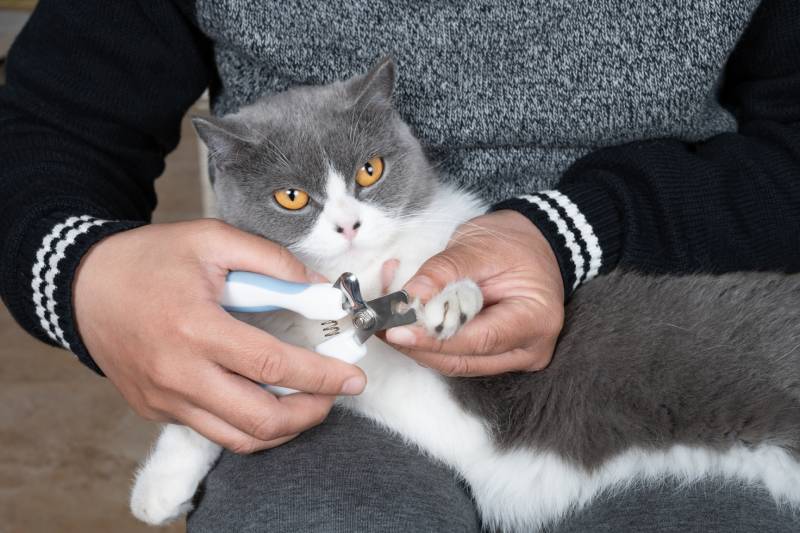
5. Breaking Up the Process
Trimming all your cat’s nails in one go is not mandatory. Here is a recommended approach:
- Trim in Stages: If your cat becomes restless, it’s perfectly okay to trim a few nails and then pause.
- Reward Their Patience: Praise your cat and offer a little treat after each session. This will make the experience positive for them.
- Wait for the Right Moment: Look for the next opportunity when your cat is calm to continue the process.
Breaking up the trimming process ensures it remains stress-free and can be enjoyable for your cat. The key is to find the right opportunity and make your cat feel comfortable.
Alternatives to Trimming
If trimming proves too stressful for your cat, consider alternatives that still keep their claws manageable. Here are a few that work well:
Use Scratch Posts
Cats scratch for multiple reasons, one of which is to keep their nails in check. But rather than let your cat scratch up your furniture, redirect this behavior toward scratch posts, which provide them with a suitable outlet.
Discourage Furniture Scratching
If you don’t have a scratch post or your cat continues to use other things in your home for personal nail care, you can protect your furniture by using deterrents like tin foil or even balloons. Either will help dissuade them from scratching.
Conclusion
With patience, gentleness, knowledge, and the right tools, trimming your cat’s nails can be a positive experience. Remember, it is all about creating a safe and comfortable environment for your feline companion. If you don’t succeed the first time or two, stay committed. You’ll get it soon enough, and don’t be ashamed to get advice or even a lesson from your vet!
See Also:
- How To Treat a Cat Scratch: 8 Vet Approved Tips
- How to Restrain a Cat for Nail Clipping: Vet-Approved Step-by-Step Guide
Featured Image Credit: RJ22, Shutterstock




